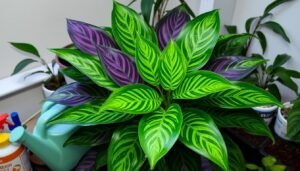Transforming your living space is easy with small indoor plants. These plants add life and are low-maintenance. They’re perfect for busy people or beginners.
Plants like succulents and peace lilies fit well in small spaces. You can place them on desks, bookshelves, or windowsills. With 21 small indoor plants to choose from, you can improve your home’s look and air quality.
Whether you want to decorate or purify the air, there’s a plant for you. The right selection of easy-care houseplants will meet your needs.
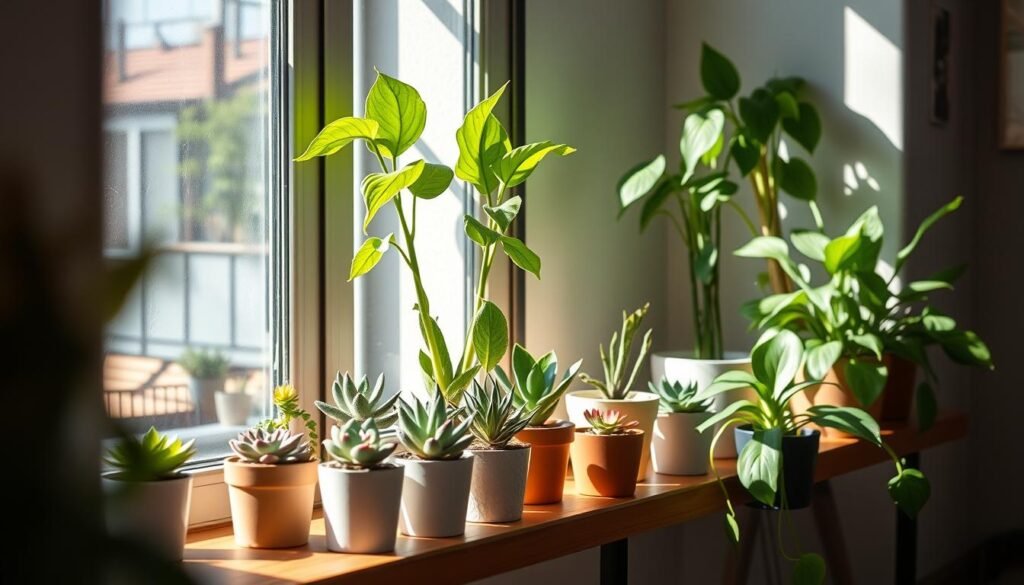
Key Takeaways
- 21 small indoor plants available with varying characteristics.
- Suitable for beginners, with easy propagation and minimal care.
- Variety of plants across different families such as succulents and lilies.
- Plants thrive in various light conditions—some require bright, indirect light.
- Many plants on the list provide air purification benefits.
Benefits of Having Small Indoor Plants
Adding small indoor plants to your home brings many benefits. They not only make your space look better but also improve your health and mood.
Improved Air Quality
We spend most of our lives indoors, so clean air is crucial. Plants like snake plants and peace lilies are great at purifying the air. A NASA study from 1989 showed they can remove harmful chemicals like formaldehyde and benzene. This makes your home or office a safer, healthier place.
Enhanced Aesthetics
Small indoor plants make any room look better. Their bright colors and textures bring a touch of nature indoors. Whether you pick green plants or ones that bloom, they can turn a dull area into a lively spot.
Stress Reduction
Studies show that plants can help reduce stress. A 2015 study found that people who cared for plants felt less stressed. Being around plants also makes us feel happier and more relaxed. So, adding plants to your home can make your life better in many ways.
| Benefit | Details |
|---|---|
| Improved Air Quality | Filters toxins like formaldehyde and benzene. |
| Enhanced Aesthetics | Adds vibrant color and texture to home decor. |
| Stress Reduction | Promotes feelings of well-being and calmness. |
Characteristics of Easy Care Small Indoor Plants
Easy care small indoor plants have special traits that make them great for beginners. They are tough and can adjust to many living situations. This lets new plant owners enjoy gardening without the stress of caring for plants.
Low Water Requirements
Plants like succulents and snake plants need very little water. They only need water when their soil is dry. This is great for people who might forget to water their plants.
These plants can handle dry periods well. This makes them perfect for beginners who might forget to water.
Adaptability to Light Conditions
These plants also adapt well to different light levels. They can grow in both bright and dim places. For example, the ZZ plant and pothos do well in low light.
This makes them ideal for city apartments with little natural light.
Durability Against Neglect
These plants can handle being forgotten or neglected. They are forgiving if you miss a watering or if the light isn’t perfect. They can recover quickly from neglect.
This makes them great for busy people who want plants but don’t have a lot of time. They ensure beginners can start gardening without worrying about failure.
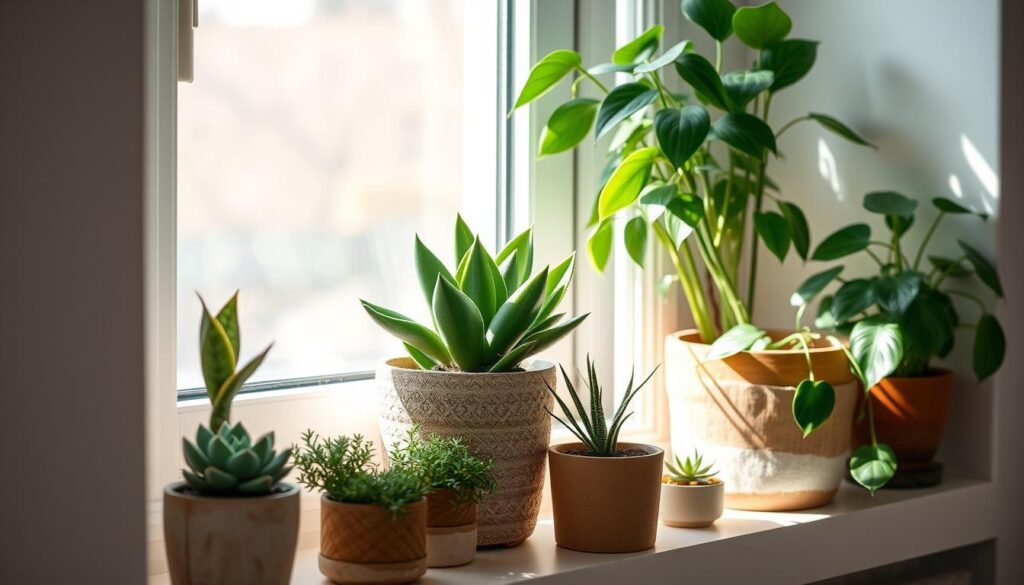
Popular Small Indoor Plants for Beginners
Starting with indoor gardening? Some small plants are perfect for beginners. They’re easy to care for and make your home brighter. Plus, they can improve your mood and health.
Snake Plant
The snake plant, or Dracaena trifasciata, is a great pick for new gardeners. It grows well in low light and needs little water. This makes it perfect for those who forget to water.
It also cleans the air, making your home healthier. This is why it’s so popular among indoor plants.
Aloe Vera
Aloe Vera is loved for its beauty and health benefits. It can help heal small burns. It prefers bright, indirect light and only needs water every few weeks.
It’s easy to care for and looks great in any room. It’s a must-have for many houseplant lovers.
Peace Lily
The peace lily, or Spathiphyllum, is known for its white flowers and air-purifying qualities. It does well in indirect light and needs water once a week.
It’s very forgiving, making it ideal for beginners. The peace lily adds beauty and improves the air in your home.
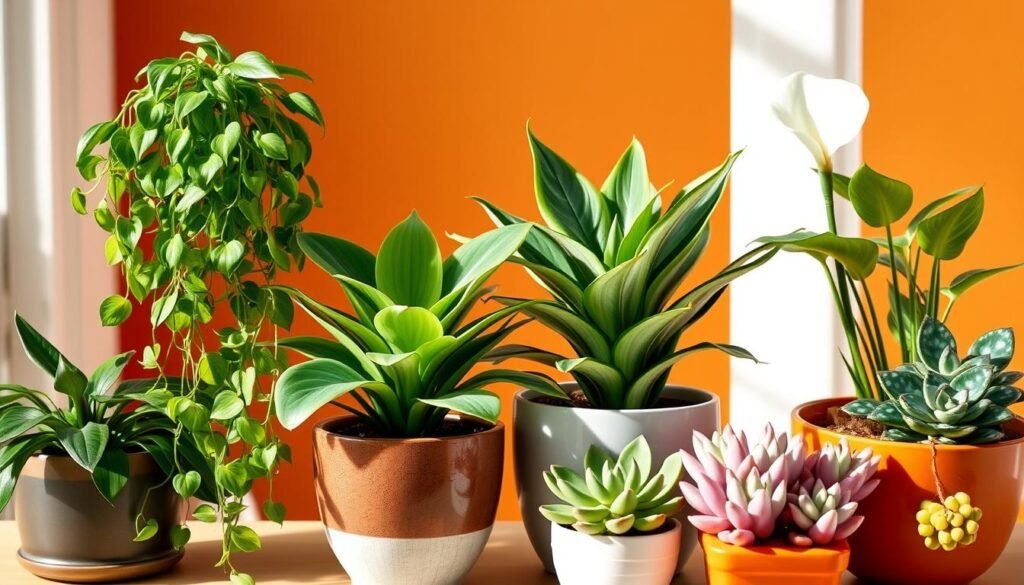
Choosing the Right Small Indoor Plants for Your Home
Choosing small indoor plants means knowing your home and habits. This choice affects how well plants do in your space. Use indoor gardening tips to pick plants that fit your lifestyle and improve your home.
Assess Your Space
First, check the light in your home. Plants need different amounts of light. Knowing your light levels helps pick the right plants. Also, think about where you’ll put the plants. Here’s a quick guide:
| Plant | Size at Maturity | Light Requirement |
|---|---|---|
| Fiddleleaf Fig | 10’ x 6’ | Bright, indirect light |
| Snake Plant | 4’ x 2’ | Low to bright light |
| Pothos | Varies (can trail or climb) | Low to bright light |
| ZZ Plant | 3-5’ x 2-3’ | Low to medium light |
| Spider Plant | 2’ x 4’ | Low to bright light |
Consider Your Lifestyle
Think about how much time you have for plant care. Busy people should choose easy plants. Plants like the ZZ plant and snake plant need little water. Here are some good picks for different lifestyles:
- Aloe Vera: Low maintenance and thrives with minimal watering.
- Peace Lily: Prefers indirect light but needs more water than most houseplants.
- Golden Pothos: Grows vigorously with limited light and infrequent watering.
- Dracaena: Easy care and adaptable to varying temperatures.
- Chinese Money Plant: Thrives in moist soil with good drainage.
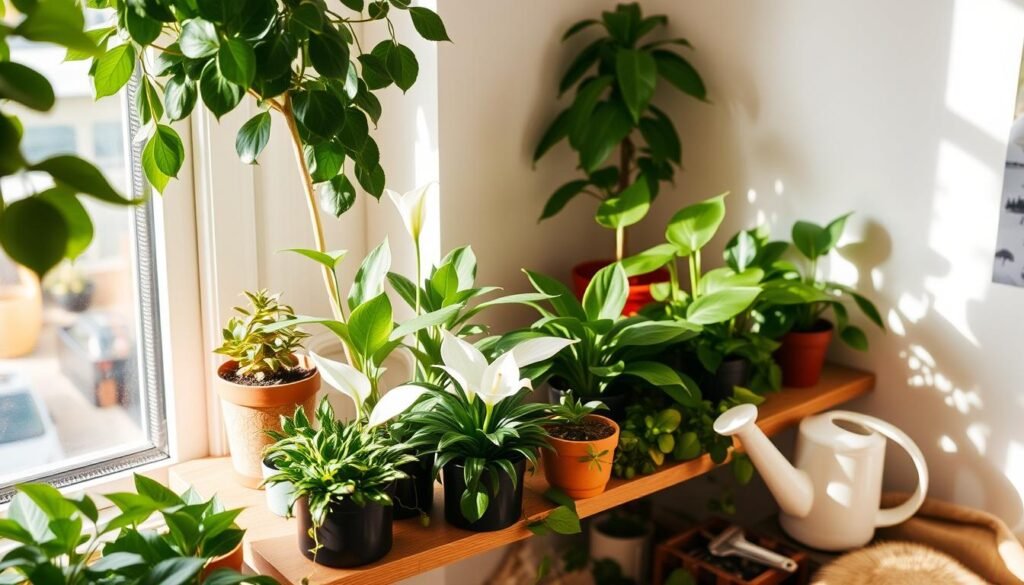
Small Indoor Plants for Low-Light Conditions
Finding plants for dark spots can be tough. Many people look for plants that do well in the shade. Indoor gardening has many options that grow well in low light, making every space green.
Cast-Iron Plant
The cast-iron plant is known for being tough. It’s great for dark rooms. It has dark green leaves that make any corner look elegant.
Pothos
Pothos is a favorite among indoor gardeners. It’s a climbing vine that looks good in different light. It can turn a dull corner into a lively spot. Pothos is perfect for hanging or trailing down.
ZZ Plant
The ZZ plant is loved for its strong leaves that hold water. It grows well in the dark. It can grow up to 3 to 4 feet tall. This plant is perfect for those who want something easy to care for.

Air-Purifying Small Indoor Plants
Adding air-purifying plants to your home makes it look better and improves the air quality. Research by NASA scientist Bill Wolverton in 1989 showed how effective these plants are. They help fight indoor air pollution. Choosing the right plants can make your home healthier and happier.
Benefits of Air-Purifying Plants
Air-purifying plants do more than just clean the air. They make you feel better, reduce stress, and boost your creativity. These plants remove harmful chemicals like formaldehyde and benzene. They turn your home into a healthier place. Make sure to pick plants that fit your room size well.
Top Air-Purifying Choices
Here are some top picks for small indoor plants:
- Peace Lily: It does well in medium to low sunlight and removes toxins.
- Spider Plant: This easy-to-grow plant absorbs carbon monoxide and formaldehyde.
- Snake Plant: It’s great for low light and removes benzene.
- Aloe Vera: It not only purifies the air but also has health benefits.
- Bamboo Palm: It’s good at removing benzene and formaldehyde, perfect for part sun to part shade.
Remember, the health and air-purifying power of these plants depend on light, water, and humidity. Opt for pet-friendly plants like Spider Plants to keep your pets safe. This way, you can enjoy a cleaner, healthier home.
Creative Ways to Style Small Indoor Plants
Adding small indoor plants to your home opens up a world of creative plant ideas. These ideas can make any space lively and full of character. Here are some new ways to style plants that show off their beauty and versatility.
Wall Gardens
Wall gardens are great for using vertical space and showing off small plants. By attaching planters to walls, you can create a beautiful green wall. Snake plants are perfect for this, adding height and balance.
Try mixing tall plants with ones that trail to add interest. This makes your room look more dynamic.
Hanging Planters
Hanging planters are both useful and stylish. They let you hang plants from ceilings, saving floor space. This style adds texture and variety, making your room lively.
Choose leafy plants like pothos or ficus for a beautiful cascade. They look great from any height.
Terrariums and DIY Projects
Terrariums are fun DIY projects. They let you show off small plants in unique ways. Use different glass containers to match your style.
This adds a whimsical touch to your space. You can add stones or figurines to make it your own.
Tips for Caring for Small Indoor Plants
Knowing how to care for your small indoor plants is key to keeping them alive and healthy. By following the right watering tips, making sure they get enough light, and fixing common problems fast, you can help your plants grow well.
Watering Guidelines
Watering is crucial for plant care. Too much water can kill your plants, so it’s important to water them right. Here are some tips for watering:
- Check the soil moisture often; most plants like the soil to be dry before watering again.
- Change how often you water based on the season and the plant type.
- Feed your plants with fertilizer in spring and summer. Use a balanced fertilizer with equal numbers.
Light Exposure Tips
Every plant needs different amounts of light to stay healthy. It’s important to put your plants in the right spot for their light needs:
- Bright light is best for succulents and some flowering plants.
- Moderate light works well for plants like ZZ plants and snake plants.
- Low light is good for ferns and other plants that don’t need much light.
Common Issues and Solutions
Dealing with plant problems early can save a lot of trouble. Here are some common issues and how to fix them:
| Issue | Symptoms | Solution |
|---|---|---|
| Overwatering | Yellowing leaves, fungus gnats | Let the soil dry out, avoid water pooling in the pot |
| Pests (e.g., aphids, spider mites) | Sticky residue, webbing | Use insecticidal soap, apply regularly |
| Diseased plants | Wilting, discoloration | Remove and destroy affected parts to stop the spread |
Cleaning your plants regularly can help them absorb light better and look better. Keep an eye on their health to solve problems quickly.
Identifying the Best Pots for Small Indoor Plants
Choosing the right pots for your small indoor plants is key to success in container gardening. The right size and material help your plants thrive and add beauty to your space. Knowing these factors helps you make choices that support healthy growth.
Choosing the Right Size and Material
Size is important when picking plant pots. For pots up to 10 inches in diameter, add one to two inches. For bigger plants, go for a two to three inch increase. For example, a ZZ plant needs a 5-inch pot after starting in a 4-inch one. A philodendron in a 12-inch pot should move to a 14-inch one.
Material choice is also crucial. Clay pots are attractive but heavy, best for larger plants. They need more water, which can be hard for some. Plastic and fiberglass pots are lighter, easier to clean, and need less water, perfect for many indoor plants.
Drainage Solutions
Drainage is vital for plant health. Make sure your pots have holes to prevent overwatering and root rot. If your pots don’t have holes, add no more than 1/3 of the container’s size in water. Choose materials like terracotta, wood, or ceramic for better drying. Repotting helps your plants grow and get fresh potting mix, supporting their health.
Conclusion
Adding small indoor plants to your home makes it look better and is good for your health. These plants help clean the air, lower stress, and boost brain power. Since we spend most of our time indoors, having plants around is very important.
They can help lower blood pressure and make kids do better in school. Caring for these plants is easy, making them perfect for anyone. A few plants can turn your home into a peaceful place that makes you feel better and work better.
Choosing the right plants and taking care of them is simple. This way, you make your home prettier and healthier. It shows that having plants around is great for your health and happiness.

